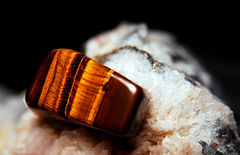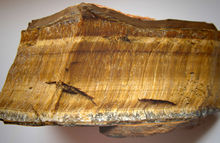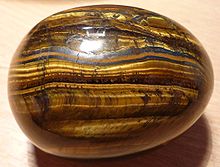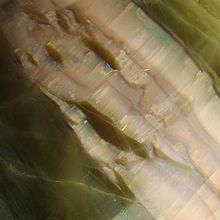- Tiger's eye
-
This article is about the gemstone. For the characters in the Sailor Moon series, see Amazon Trio.
Tiger's Eye 
Polished tiger's eye gemstoneGeneral Category Mineral Chemical formula Silica (silicon dioxide, SiO2) Identification Color golden to red-brown Mohs scale hardness 7.0 Luster Silky Specific gravity 2.64 – 2.71 Tiger's eye (also called Tigers eye or Tiger eye) is a chatoyant gemstone that is usually a metamorphic rock that is a golden to red-brown color, with a silky luster. A member of the quartz group, it is a classic example of pseudomorphous replacement by silica of fibrous crocidolite (blue asbestos). An incompletely silicified blue variant is called Hawk's eye.
Contents
Cut, treatment, and imitation
The gems are usually cut en cabochon in order to best display their chatoyancy. Red stones are brought about through gentle heat treatment. Dark stones have had their colors improved and been artificially lightened using nitric acid treatments.[1]
Honey-colored stones have been used to imitate the much higher valued cat's eye chrysoberyl (cymophane), but the overall effect is unconvincing. Artificial fiberoptic glass is a common imitation of tiger's eye, and is produced in a wide range of colors. Tiger's Eye mostly comes from South Africa and East Asia.
Tiger iron
Tiger iron is an altered rock composed chiefly of tiger's eye, red jasper, and black hematite. The undulating, contrasting bands of color and luster make for an attractive motif, and it is mainly used for jewelry-making and ornamentation. Tiger iron is a popular ornamental material used in a variety of applications, from beads to knife hilts.
Tiger iron is mined primarily in South Africa and Western Australia. Tiger's eye is composed chiefly of silicon dioxide (SiO2) and is colored mainly by iron oxide. The specific gravity ranges from 2.64 -2.71.[2] It is formed by the alteration of crocidolite.
Other forms of tiger's eye
Arizona and California have serpentine deposits in which are occasionally found chatoyant bands of chrysotile fibers. These have been cut and sold as "Arizona tiger-eye" and "California tiger's eye" gemstones.[3][4]
Occurrence
Notable sources of tiger's eye include Australia, Burma, India, Namibia, South Africa, United States,[5] Brazil, Canada, China, Korea and Spain.[citation needed]
References
- ^ O'Donoghue, Michael (1997). Synthetic, Imitation, and Treated Gemstones. Boston, Massachusetts: Butterworth-Heinemann. pp. 125–127. ISBN 0-7506-3173-2.
- ^ http://ist-socrates.berkeley.edu/~eps2/wisc/sg.html Berkeley.edu
- ^ Flagg, Arthur Leonard (1958). Mineralogical Journeys in Arizona. Scottsdale: F.H. Bitner. pp. 92–93.
- ^ USGS (1908–1909). "Cat's Eye or Tiger-Eye". Mineral Resources of the United States / Department of the Interior, United States Geological Survey (Washington, D.C.: US Government Printing Office) 2: 802.
- ^ Schumann, Walter (3009). Gemstones of the World (Fourth ed.). New York, New York: Sterling Publishing. p. 140. ISBN 978-1-4027-6829-3.
External links
Crystalline Cryptocrystalline Amorphous Miscellaneous Quartzite · Tiger's eyeNotable varieties Categories:- Gemstones
- Quartz varieties
Wikimedia Foundation. 2010.




